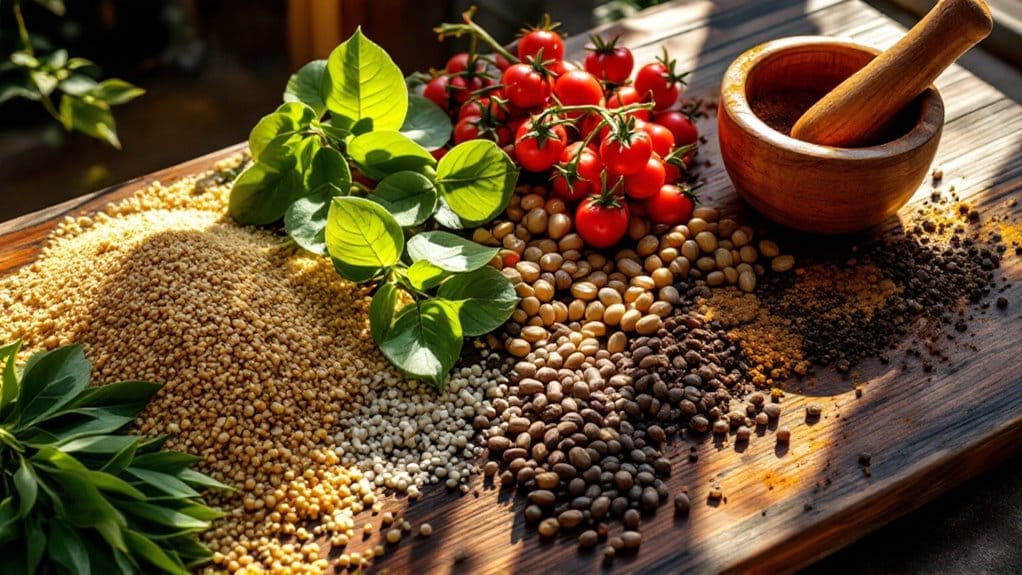Exploring indigenous ingredients in African cuisine opens up a vibrant world of flavors that enrich your meals and reflect cultural heritage. You'll discover native grains like millet and teff, hearty legumes such as cowpeas, and unique oils like palm and groundnut that enhance heart health. Each region offers distinct ingredients, from couscous in North Africa to groundnut stew in Central Africa, showcasing diverse agricultural practices. These ingredients not only nourish the body but also tell stories of community and tradition. Keep going to uncover the significance of sustainable practices and learn more about the connection between food, culture, and environment.
Key Takeaways
- Indigenous ingredients like millet, sorghum, and teff promote biodiversity and enhance the nutritional value of African dishes.
- Unique legumes such as cowpeas and Bambara groundnuts offer essential protein and versatility in traditional recipes.
- Local fruits and vegetables, including baobab and moringa, provide antioxidants that boost immune function and reflect culinary heritage.
- Sustainable sourcing practices encourage the use of native crops, supporting local economies and preserving biodiversity.
- Traditional cooking methods foster community connections and enhance the flavors of dishes like Moroccan tagine and West African groundnut stew.
Indigenous Ingredients Overview
Indigenous ingredients play an essential role in African cuisine, with native grains like millet, sorghum, and teff forming the backbone of many regional dishes. These grains not only provide crucial nutrients but also connect you to the rich culinary heritage of the continent.
When you explore traditional meals, you'll discover unique legumes like cowpeas and Bambara groundnuts, which add protein and versatility to your stews and side dishes.
Cooking with native oils, especially palm oil and groundnut oil, enhances the flavors of your dishes while offering health benefits. You'll appreciate how these oils contribute to the authenticity of your meals, making them truly special.
Spices, such as grains of paradise and African bird's eye chili, elevate your cooking with vibrant flavors, often found in traditional spice blends that have been passed down through generations.
Don't forget the local fruits and vegetables, like baobab, moringa, and bitter leaf, which reflect the biodiversity of African ecosystems. Incorporating these indigenous ingredients into your cooking not only celebrates the flavors of Africa but also fosters a sense of belonging to a rich and diverse culinary tradition.
Regional Ingredient Highlights
Exploring the rich tapestry of African cuisine reveals a diverse array of regional ingredients that each tell a unique story.
In North African cuisine, you'll find couscous made from semolina wheat, paired beautifully with aromatic spices like cumin, coriander, and saffron that elevate traditional dishes.
West African cuisine shines with staples such as yams, cassava, and plantains, where Jollof rice bursts with the flavors of tomatoes, bell peppers, and a mix of spices, creating a rich experience for your palate.
Venture into Central Africa, and you'll discover groundnut (peanut) and bitter leaves, featured in hearty stews like Ndolé that celebrate local vegetables and meats.
East African cuisine introduces you to teff for making injera and coconut milk, enhancing seafood dishes while showcasing the region's agricultural diversity and coastal influences.
Traditional Cooking Methods
When you think about traditional African cooking methods, clay pot cooking and open fire techniques come to mind.
Using clay pots allows for even heat distribution, enhancing the flavors of your stews and soups.
Meanwhile, cooking over an open fire adds a smoky richness that can't be replicated, making every meal a celebration of heritage.
Clay Pot Cooking
Clay pot cooking stands as a cherished tradition in many African cultures, celebrated for its ability to enhance the flavors of stews and soups. By utilizing traditional techniques, you'll discover that this method allows for slow cooking, bringing out rich flavors that truly represent the essence of local ingredients.
The porous nature of clay pots keeps moisture locked in, resulting in tender meats and concentrated tastes that make every meal special. Gathering around a clay pot for communal cooking not only nourishes the body but also strengthens social bonds within families and communities.
It's a chance to share stories and create lasting memories over dishes that are often passed down through generations. Signature dishes like Moroccan tagine and West African groundnut stew showcase the versatility of this traditional cooking vessel, demonstrating its importance in culinary heritage.
When you embrace clay pot cooking, you're not just preparing a meal; you're participating in a rich tapestry of culture and connection. As you stir and savor, you're part of a legacy that celebrates the land and its people, bringing everyone together around the warmth of shared food and laughter.
Open Fire Techniques
Open fire cooking is a vibrant tradition that complements the rich practices of clay pot cooking, adding another layer of flavor and cultural significance to African cuisine. This traditional method, prevalent across many African cultures, uses wood or charcoal to impart a distinct smoky flavor to various dishes. It connects you to your heritage while highlighting the importance of patience and skill in meal preparation.
Many indigenous dishes, like stews and soups, thrive on slow cooking techniques over open flames, enhancing flavors through gentle heat distribution. Grilling over open fires not only enriches taste but also showcases the resourcefulness of African cooking.
Here's a quick overview of open fire techniques:
| Technique | Description |
|---|---|
| Slow Cooking | Enhances flavors gently |
| Grilling | Adds unique taste |
| Wood/Charcoal | Imparts smoky flavor |
| Cultural Legacy | Preserves culinary practices |
Embracing open fire cooking allows you to experience the authenticity in African cuisine while connecting with the community and tradition. As you explore these culinary practices, you'll find a warm sense of belonging and appreciation for the heritage behind each dish.
Nutritional Benefits of Indigenous Foods
Indigenous foods pack a powerful punch when it comes to nutrition, offering a wealth of essential nutrients that can greatly boost your health. By incorporating these traditional African ingredients into your meals, you're not just embracing culture but also enhancing your well-being.
Consider the following benefits of indigenous foods:
- High protein and fiber from fonio and teff, essential for muscle repair and digestive health.
- Antioxidants found in moringa and baobab, known to enhance immune function and lower chronic disease risk.
- Complex carbohydrates in cassava and sweet potatoes, providing energy while being low in fat and rich in vitamins A and C for healthy skin and vision.
- Healthy fats from local oils like palm and groundnut, promoting heart health and reducing inflammation.
These foods aren't only nourishing but also connect you to a rich heritage.
By embracing their nutritional value, you're supporting your metabolic health and making choices that matter.
Cultural Significance of Ingredients
When you explore indigenous ingredients in African cuisine, you uncover deep connections to heritage and identity.
These foods aren't just staples; they embody sustainable sourcing practices that honor the environment and local communities.
Heritage and Identity
In African cuisine, the ingredients you choose tell a story about heritage and identity. Each dish you create resonates with the echoes of your ancestors, weaving together the past and present. By embracing indigenous ingredients, you not only honor traditional recipes but also celebrate your cultural identity.
Consider the remarkable elements that define your culinary heritage:
- Maize, yams, and cassava: staples that reflect local agricultural practices and community resilience.
- Native oils like palm oil and groundnut oil: they enhance flavor profiles while connecting you to the land.
- Indigenous spices such as grains of paradise and berbere: these enrich your dishes with a depth of flavor that tells stories of generations.
- Slow cooking in clay pots: a technique that embodies patience and skill, bridging modern cooking with ancestral traditions.
The cultural significance of these ingredients is profound. They serve as a crucial link to the identity of African communities, reminding you that every meal is a celebration of your roots and shared experiences.
Embrace these elements, and you'll find a sense of belonging in each bite.
Sustainable Sourcing Practices
Embracing sustainable sourcing practices not only benefits the environment but also deepens your connection to culinary traditions. By incorporating indigenous ingredients like fonio, teff, and sorghum, you support biodiversity and strengthen local agricultural systems. These ingredients are often gathered sustainably, ensuring the preservation of ecosystems while providing essential nutritional benefits to your community.
Using native oils, such as palm oil and groundnut oil, reinforces sustainable sourcing practices that connect you to your natural environment and bolster local economies. Each ingredient carries cultural significance, infusing your meals with historical and social meaning that fosters community identity and heritage.
Sustainable sourcing practices encourage the cultivation of adaptable crops, which thrive in local climates and require fewer resources than non-native varieties. By choosing these indigenous ingredients, you not only enjoy their nutritional benefits but also contribute to a larger movement that values biodiversity and resilience.
Sustainable Practices in African Cuisine
How does the rich tapestry of African cuisine reflect sustainable practices? By embracing indigenous ingredients and traditional cooking methods, you'll find a culinary landscape that not only nourishes but also respects the environment. Here's how these practices manifest:
- Nutritional-rich native crops like millet and sorghum thrive in local climates, promoting sustainable agriculture.
- Slow cooking and steaming methods markedly reduce energy consumption, making cooking both efficient and eco-friendly.
- Local sourcing of seasonal produce and wild foraged foods minimizes transportation emissions, enhancing environmental sustainability.
- Community-based food systems foster a sense of belonging and preserve biodiversity, encouraging the cultivation of diverse crops.
When you engage with African cuisine, you're not just savoring flavors; you're participating in a movement that prioritizes sustainability. By choosing to support local economies and native crops, you contribute to a healthier planet.
This community-centered approach creates a space where culinary traditions thrive, and knowledge about sustainable practices is shared. In this way, African cuisine serves as a beautiful bridge between nourishment, culture, and environmental stewardship, reminding us that what we eat can truly make a difference.
Frequently Asked Questions
What Are the Indigenous Ingredients of Africa?
When you think about indigenous ingredients of Africa, consider sorghum varieties and teff grain, both staples in many diets.
You'll find native legumes like cowpeas and fonio seeds enriching meals, while wild greens and traditional herbs add freshness and flavor.
Don't forget the baobab fruit, packed with nutrients, and palm oil, a cooking essential.
Yams have deep origins in African culture, showcasing the continent's rich culinary heritage and diversity.
What Two Ingredients From the Americas Introduced in the 1500S Have Made Their Way Into African Cuisine as Popular Ingredients?
You might be surprised to learn that maize and sweet potatoes, both from the Americas, became essential in African cooking after their introduction in the 1500s.
Maize's origins brought about new porridge and fufu recipes, while sweet potato varieties enriched stews across many regions.
This culinary adoption not only showcases the rich tapestry of African cuisine but also highlights the vibrant connections formed through cultural exchanges, creating a true sense of belonging in shared meals.
What Food Is Native to Africa?
When you think about foods native to Africa, consider traditional staples like millet, sorghum, and cassava. Each region showcases its own variations, using unique culinary techniques and agricultural practices.
Seasonal foods play an essential role, reflecting cultural significance and diverse flavor profiles. You'll find different cooking methods, from steaming to frying, that enhance the nutritional value of these ingredients.
Plus, food preservation techniques guarantee these treasures can be enjoyed year-round.
Which of These Ingredients Are Commonly Used in African Recipes?
As the saying goes, "You are what you eat," and in Africa, that means embracing a rich tapestry of flavors.
You'll find traditional spices and local herbs elevating staple grains like maize and millet. Ancient legumes such as lentils add protein, while wild vegetables and indigenous fruits enhance nutrition and cultural significance.
Fermented foods and foraged ingredients showcase unique culinary techniques, creating dishes that connect you to a vibrant heritage and community.
Conclusion
Exploring indigenous ingredients in African cuisine reveals a vibrant tapestry of flavors and traditions. Did you know that over 1,000 native plant species are used across the continent? By incorporating these ingredients into your cooking, you not only savor unique tastes but also support sustainable practices and cultural heritage. Embracing these foods connects you to Africa's rich history while promoting health and nutrition. Immerse yourself in this culinary adventure, and let the essence of Africa inspire your kitchen!








